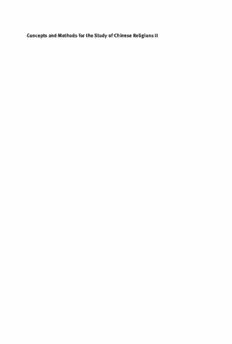Table Of ContentConceptsandMethodsfortheStudyofChineseReligionsII
Religion and Society
Edited by
Gustavo Benavides, Frank J. Korom,
Karen Ruffle and Kocku von Stuckrad
Volume 78
Concepts and Methods
for the Study of
Chinese Religions II
Intellectual History of Key Concepts
Edited by
Gregory Adam Scott and Stefania Travagnin
ISBN978-3-11-054644-6
e-ISBN(PDF)978-3-11-054782-5
e-ISBN(EPUB)978-3-11-054713-9
ISSN1437-5370
LibraryofCongressControlNumber:2019958027
BibliographicinformationpublishedbytheDeutscheNationalbibliothek
TheDeutscheNationalbibliothekliststhispublicationintheDeutscheNationalbibliografie;
detailedbibliographicdataareavailableontheInternetathttp://dnb.dnb.de.
©2020WalterdeGruyterGmbH,Berlin/Boston
Typesetting:IntegraSoftwareServicesPvt.Ltd.
Printingandbinding:CPIbooksGmbH,Leck
www.degruyter.com
永恆懷念
蔡彥仁老師
(1956–2019)
故人不可見,
漢水日東流。
借問襄陽老,
江山空蔡州。
~唐·王維〈哭孟浩然〉
Preface
Religion in late-Imperial and twentieth-century China has been the object of a
largenumberofpublicationsinthepastfewdecades.Thesestudiesusedarchi-
val and ethnographic research, but also relied upon an earlier generation of
scholarshipthathadopenedthefieldandcreateditsmethodologicalandtheo-
retical foundations. Part of this early scholarship did not result from the work
of traditional academics, but from explorers or photographers, and thus en-
riched the discourse of religion in modern China with different and less aca-
demic perspectives. Parallel to this publishing production, the organization of
conferences,theestablishmentofresearchcentersandthecreationofinterna-
tional research networks on this theme have multiplied steadily. This flood of
new research reflects the fact that the study of religions in modern China has
emergedasanewandchallengingfieldinbothAsianandWesternacademia.
Withinthisemergingrichfieldofstudy,however,thereisstillanongoing
debateregardingwhatmethodsandtheoriesareappropriatetobeemployedin
this new field. The three-volume publication Concepts and Methods for the
Study of Chinese Religions contributes to this debate. It reviews the past his-
tory of the field, highlights challenges that the scholars in this field have en-
countered, reconsiders the present state of analytical and methodological
theories, and finally opens up a new chapter in the history of concepts and
methodsforthefielditself.
These three volumes explore religion in the area known as greater China,
whichincludesmainlandChina,HongKong,andTaiwan.Amongtheauthors,
some have been trained and have published in the fields of anthropology and
sociology;othersarehistorians,textualscholars,areastudiesscholars,andpo-
litical scientists. The three volumes present the results of a constructive dia-
logue and mutual integration of various disciplines of humanities and social
sciences.Thispublicationalsoaimstocontributetoadiscussiononanalytical
and theoretical concepts that could potentially be applied to the study of reli-
gioninothercontexts,includinginWesternsocieties.Inotherwords,Chinais
seen not as an exotic outlier, but as a global player in the overall academic
study of religion. Such a framework responds to the current call for interdisci-
plinary and cross-tradition debates on a trans-regional horizon and globaliza-
tion, and thus methodologies for the study of East Asian religions should be
engagedwithWesternvoicesinamoreactiveandconstructivemanner.
Thefirstvolume,ConceptsandMethodsfortheStudyofChineseReligions
I: State of the Field and Disciplinary Approaches, starts with an assessment of
the earliest works and individuals who initiated the study of religion in modern
China. Those individuals include Western and Chinese religious practitioners,
https://doi.org/10.1515/9783110547825-202
VIII Preface
academic figures, explorers and photographers. The earliest works are predomi-
nantly textual, historical and ethnographic studies: these form the foundation of
thefield.Questionsaddressed include:Whoarethepioneersinthestudyof reli-
gion in modern China and Taiwan? What were the first disciplinary approaches,
conceptual categories, and objects of research? How did those choices shape the
beginning of the field as well as the academic output of today? What were their
contributionsandtheirlimitations,andhowcanweworktoovercomethoseshort-
comings?Thesecondpartofthefirstvolumediscussesmethodologicalanddisci-
plinary approaches that are currently used in the study of religion in modern
ChinaandTaiwan,withconstructiveconclusionsonpotentialchangesinresearch
trajectories,andthusworkstowardanoverdueimprovementofresearchmethods.
Thechaptersaddressmethodologicaldisciplinessuchasanthropology,sociology,
political science, and history, in their own micro-contexts as well as in the ways
theyrelatetomacro-fields.
Thesecondandthirdvolumesshiftthefocusfrommethodologicalconcerns
tocriticalreflectionsonanalyticalconcepts,andincludethere-evaluationofcon-
ceptsandpracticesthatinformthereligioussphereandscholarshipinthefield.
These two volumes look at endogenous Chinese concepts and exogenous ideas
fromtheWestandJapanthatarefoundationalinthinkingabouttheChinesereli-
giouslandscape.Somechaptersaddresstheintroductionofnewconceptsorthe
reshapingoftraditionalonesinlightoftheintellectual,political,andsocialatmo-
sphere of the late nineteenthcenturyand the early Republican period in China,
whileothersassessideasthatcontinuetopermeatethereligioussphereofChina
andTaiwantoday.Thesekeyconceptsareallinterconnectedbecausetheypartic-
ipateinthesamedebatesontraditionaldichotomiesandrecentparadigmshifts.
Concepts and Methods for the Study of Chinese Religions II: Intellectual
History of Key Concepts analyzes key concepts in their intellectual history and
development: these are concepts that have become core terms in Chinese reli-
gions but have each their own history of formation and use. Concepts and
MethodsfortheStudyofChineseReligionsIII:KeyConceptsinPracticeanaly-
ses another set of concepts that form the foundations of the Chinese religious
sphere.Adoptinganapproachthatdiffersfromthatofthesecondvolume,these
conceptsarestudiedthroughtheirpraxisinlivedreligions.
This project developed from the conference Framing the Study of Religion
in Modern China and Taiwan: Concepts, Methods and New Research Paths,
which was sponsored by the Chiang Ching-kuo Foundation for International
Scholarly Exchange and the KNAW (Koninklijke Nederlandse Akademie van
Wetenschappen), and was held at the University of Groningen in December
2015.
Acknowledgments
Preliminary drafts of the chapters by Ester Bianchi, Adam Yuet Chau,
Jason T. Clower, Erik Hammerstrom, Ya-pei Kuo, Gregory Adam Scott, and
Stefania Travagnin were presented at the international conference Framing the
Study of Religion in Modern China and Taiwan: Concepts, Methods and New
Research Paths, held at the University of Groningen on December 9–12, 2015.
We would like to express our heartfelt gratitude to the Chiang Ching-Kuo
Foundation for International Scholarly Exchange and the KNAW (Koninklijke
Nederlandse Akademie van Wetenschappen) for their sponsorship, which
helped make the meeting possible. The discussions that took place during the
conferencewereessentialforauthorsastheyrevisedtheirchapters.
Each author has included specific acknowledgments in their own chapters.
Herethevolumeeditorswouldliketoexpresstheirindebtednesstotheanony-
mous reviewers of the manuscript, who offered significant and constructive
feedbackthathelpedallofthecontributorsenhancetheirstudies.
Last but not least, we are deeply thankful to the editors of the book series
ReligionandSocietyatDeGruyterfortheunstintingguidanceandsupportthey
providedforourproject.
https://doi.org/10.1515/9783110547825-203

